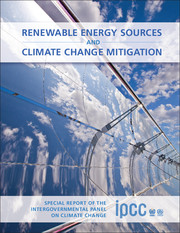 Renewable Energy Sources and Climate Change Mitigation
Renewable Energy Sources and Climate Change Mitigation Book contents
- Frontmatter
- Contents
- Section I
- Section II
- Section III
- Chapter 1 Renewable Energy and Climate Change
- Chapter 2 Bioenergy
- Chapter 3 Direct Solar Energy
- Chapter 4 Geothermal Energy
- Chapter 5 Hydropower
- Chapter 6 Ocean Energy
- Chapter 7 Wind Energy
- Chapter 8 Integration of Renewable Energy into Present and Future Energy Systems
- Chapter 9 Renewable Energy in the Context of Sustainable Development
- Chapter 10 Mitigation Potential and Costs
- Chapter 11 Policy, Financing and Implementation
- Section IV
- Index
- References
Chapter 5 - Hydropower
Published online by Cambridge University Press: 05 December 2011
- Frontmatter
- Contents
- Section I
- Section II
- Section III
- Chapter 1 Renewable Energy and Climate Change
- Chapter 2 Bioenergy
- Chapter 3 Direct Solar Energy
- Chapter 4 Geothermal Energy
- Chapter 5 Hydropower
- Chapter 6 Ocean Energy
- Chapter 7 Wind Energy
- Chapter 8 Integration of Renewable Energy into Present and Future Energy Systems
- Chapter 9 Renewable Energy in the Context of Sustainable Development
- Chapter 10 Mitigation Potential and Costs
- Chapter 11 Policy, Financing and Implementation
- Section IV
- Index
- References
Summary
Executive Summary
Hydropower offers significant potential for carbon emissions reductions. The installed capacity of hydropower by the end of 2008 contributed 16% of worldwide electricity supply, and hydropower remains the largest source of renewable energy in the electricity sector. On a global basis, the technical potential for hydropower is unlikely to constrain further deployment in the near to medium term. Hydropower is technically mature, is often economically competitive with current market energy prices and is already being deployed at a rapid pace. Situated at the crossroads of two major issues for development, water and energy, hydro reservoirs can often deliver services beyond electricity supply. The significant increase in hydropower capacity over the last 10 years is anticipated in many scenarios to continue in the near term (2020) and medium term (2030), with various environmental and social concerns representing perhaps the largest challenges to continued deployment if not carefully managed.
Hydropower is a renewable energy source where power is derived from the energy of water moving from higher to lower elevations. It is a proven, mature, predictable and typically price-competitive technology. Hydropower has among the best conversion efficiencies of all known energy sources (about 90% efficiency, water to wire). It requires relatively high initial investment, but has a long lifespan with very low operation and maintenance costs. The levelized cost of electricity for hydropower projects spans a wide range but, under good conditions, can be as low as 3 to 5 US cents2005 per kWh.
- Type
- Chapter
- Information
- Renewable Energy Sources and Climate Change MitigationSpecial Report of the Intergovernmental Panel on Climate Change, pp. 437 - 496Publisher: Cambridge University PressPrint publication year: 2011
References
- 67
- Cited by


